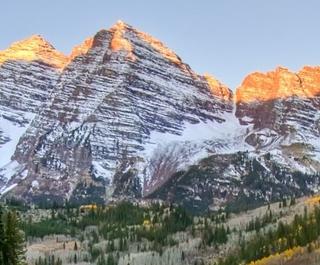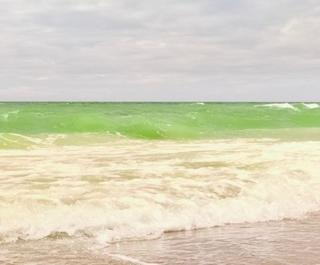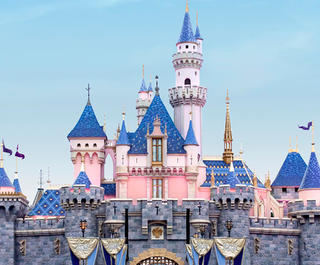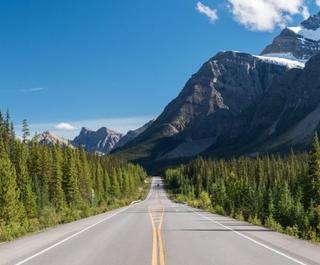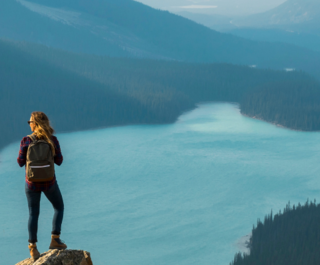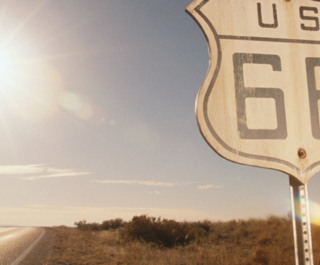
The first time I crossed west of the Missouri-Kansas border was at age 21, when I moved to Santa Fe, New Mexico, in the southwestern corner of the United States. Born and raised on a farm in the heart of Midwest prairie land, stepping off that plane in Santa Fe also happened to be the first time I ever saw a proper mountain. The mountains that jutted up from the rusted brown earth of the high desert and greeted me were the famous Rockies – which stretch more than 4,800km across North America. New Mexico may be the southern terminus of the range, but this is where my relationship with the wild lands of America began.
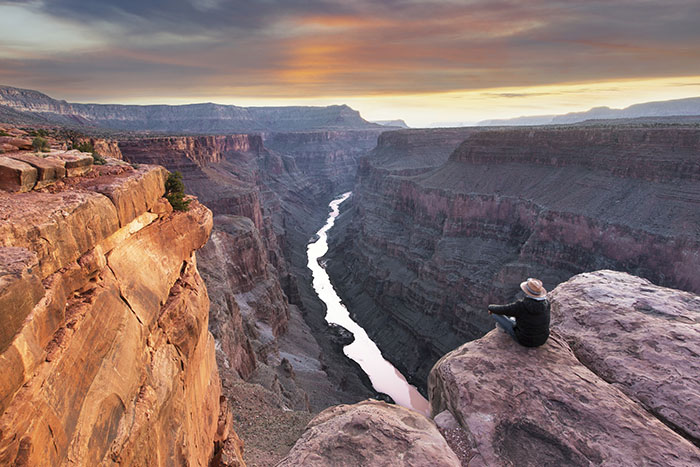 Sunrise at Toroweap Point, on the north rim of the Grand Canyon.
Sunrise at Toroweap Point, on the north rim of the Grand Canyon. I wasted no time getting past city limits, parking lots, and entry gates to get into the wild. But one day on a scramble up to Battleship Rock in the Santa Fe National Forest among burping hot springs and blanketing coniferous forest, I panicked. What if this new-found enthralment with the monumental backyard of the USA would lose a scrap of its allure with every step I took into it? What if every hike across rims of red rock canyons, every amble through sagebrush-filled valleys, and every view of icy peaks was the first of the last of my discoveries? The fear within me felt like somehow finding access to the backcountry was comparable to finally unearthing a buried treasure chest after a lifetime spent hearing of and pursuing its existence. Being here on this unmarked trail in the middle of a mountain range surrounded by a beautiful landscape, the hunt for the cache was over. Now what?
Well, after you find the treasure you can cash it in. No minute I spend in protected lands trekking across trails padded with aspen leaves and pine needles or past delicate-looking waterfalls or under rugged alabaster limestone cliffs goes without paying me back tenfold in experiences that I couldn’t anticipate.
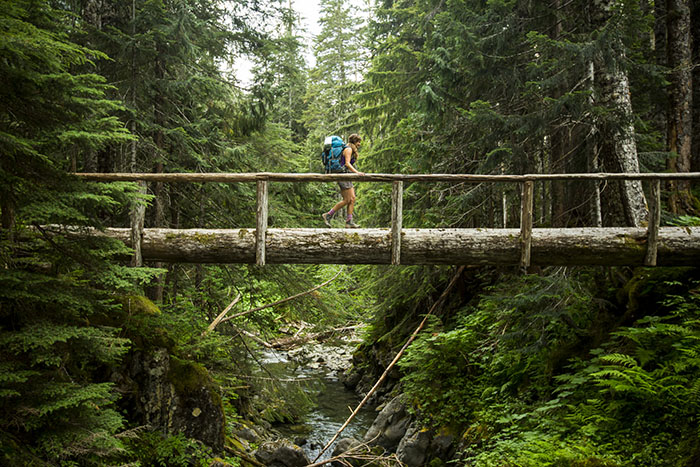 Getting lost on the trail in Olympic National Park.
Getting lost on the trail in Olympic National Park. Every day spent in the backcountry feels like walking off that plane and witnessing an original work of lively terrain. From Olympic National – where I lay with my camping companions on the wet sand of the cliff-framed Shi Shi Beach, looking up into a kaleidoscope of more stars than I imagined could fit into a sky – to my first trek across the gypsum dunes of White Sands National Monument – which cast the rosy sunset back with the reflection of a billion crystals – I quickly realised that opening the treasure chest of the wilderness was just the beginning of finding America’s wild.
The state and national parks, monuments, and forests of the USA are places where the old adage, “If you’ve seen one, you’ve seen them all” never applies. From Niagara Falls pouring out a grandiose border between the USA and Canada, to the dramatic array of rust-red gorges and steep ravines of the dramatically carved Grand Canyon, there is no way to see the same thing twice when getting outside in America. There are only a few words to call a mountain or describe a river, but the experiences that you have and the memories that you create in the more than one million square kilometres of protected public lands of America are boundless. And more importantly, they are yours.
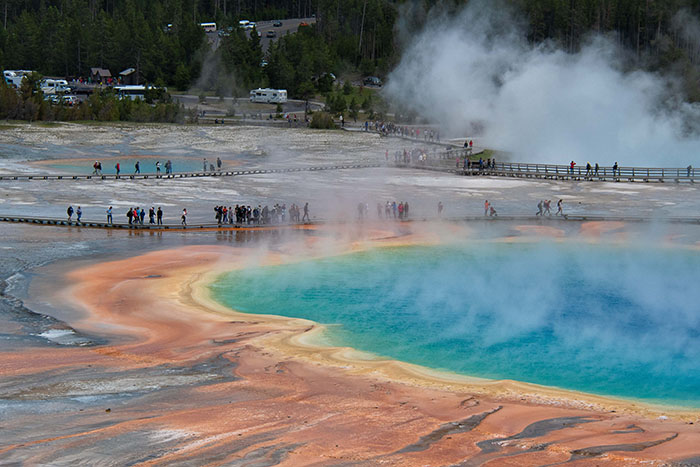 The Grand Prismatic Spring is certainly a highlight at Yellowstone National Park. (Image: Vicki Fletcher)
The Grand Prismatic Spring is certainly a highlight at Yellowstone National Park. (Image: Vicki Fletcher)Yellowstone National Park saw over four million visits in 2016. One of those was mine. My childhood friend Shinea and I packed up her tried-and-true Subaru and drove from Livingston, Montana, to the iconic North Entrance of the park in the sleepy, rural town of Gardiner to tour the Grand Loop Road. The Grand Loop circles the most iconic areas of the park, including stops at the Old Faithful geyser and the Lamar Valley.
Before we even crossed into the park a passive herd of bison greeted us from the local high school’s football field where they lazed about – unconcerned by boundaries or any sort of designated territory. This is the Wild West. We drove past them and the ‘Welcome’ signage and pulled onto the Grand Loop – which takes four to seven hours to drive in total (or nine hours, if you’re like me and are inclined to pull off the road and do some exploration by foot – which is how all the original explorers did it).
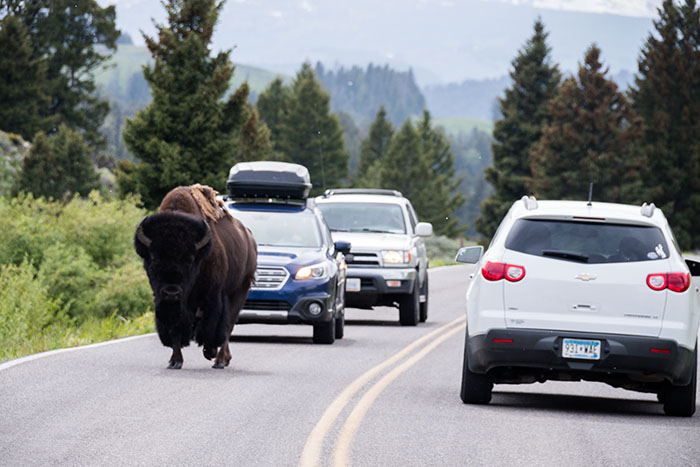 A Yellowstone traffic jam. (Image: Vicki Fletcher)
A Yellowstone traffic jam. (Image: Vicki Fletcher)Fortunately, we were in the park on a colder-than-average weekday afternoon in early spring, and the only other visitors we were sharing views of the jagged Absaroka Mountains and tricky-to-spot wildlife with were intrepid retirees. Since the park can get notoriously congested in the summer months, having the road and the glacial valleys dotted with sizzling fumaroles to ourselves was a gift. By the time we pulled off for a midday jaunt through Canyon Village, nestled smack bang in the middle of the park, we had counted more run-ins with wildlife than with other humans. Bison, elk, foxes, bighorn sheep, and one of the park’s elusive legendary grey wolves – whose population rings in at less than 100 wolves scattered in 10 packs across the 8,989sqkm of the park – kept us in good company.
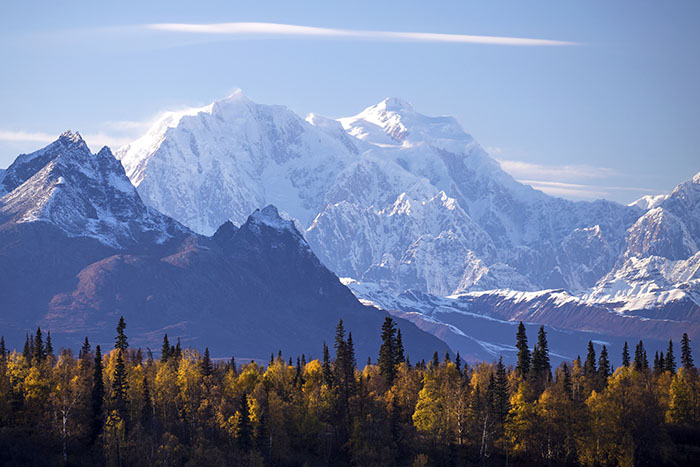 The distinctive peaks of Denali National Park in Alaska rise dramatically from the plains.
The distinctive peaks of Denali National Park in Alaska rise dramatically from the plains. Far away from the rest of the United States is Denali National Park and Preserve in Alaska, which will teach anyone with enough gumption and guts what ‘wild’ really means. The storied mountain that watches over the Last Frontier is the namesake of the park, and beneath its 6,190m summit lies some of the most pristine and dangerous land that America claims. After car camping on a -10°C October night at the Riley Creek Campground, I dusted the snow flurries off myself and wandered into a ranger station. Upon enquiring about nearby trails and good day hikes I was met with this response: “You know, we don’t have many marked trails or maintained areas within the park because dictating how people explore the wilderness defeats the purpose of what the wilderness is. If you can’t take care of yourself out there without a trail or a guide telling you how to do it, you probably shouldn’t be out there.”
With that, I took off on an unmarked trail at the base of the mountain that the station rested beneath and headed for elevation, knowing that what goes up must come down. After running and scrambling up rocky crags covered in dusty snow and hardy lichens, I found myself breathless with lungs and legs burning atop Mount Healy. The clouds were beneath me and Denali was above – holding court as the beautiful brute of a primitive, mountainous kingdom that felt so far away from anything safe and civilised.
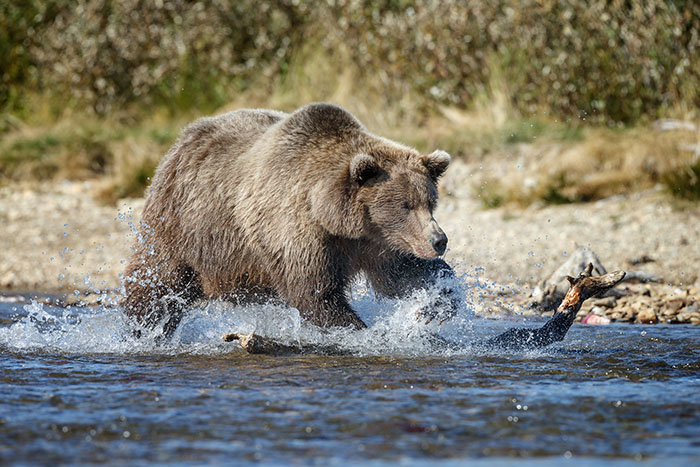 Alaskan grizzlies fishing on the Kenai River.
Alaskan grizzlies fishing on the Kenai River. In a place as intense as Alaska – where the government protects 420,873sqkm of land – you learn to surprise yourself. Areas such as the Knik Glacier test you and teach you. After setting up camp on the black ice of the glacier, my travel companions and I strapped on harnesses and crampons and set to climb the azure- blue ice formations that erupt from the glacier’s moraine crevasses with our guides from the Knik River Lodge. With each intentional kick of my toe spikes into the ice and each hoist of my legs, my guts churned with adrenaline and uncertainty: one slip could lead to bottomless blue and no escape. That night, sitting around the fire pit we’d built from stones gathered from the snout of the glacier and roasting trout we had caught earlier in the week on the Kenai River, I thought to myself: this is the type of lionhearted travel experience that you can’t plan for, but you find yourself in whenever you travel past road access and mobile phone service.
It’s the novelty of adventure that America’s wilderness lands evoke that makes them so special to travel to and through. No matter how many park gates you enter, campsites you claim, or excursions you set out on, every adventure into the wilderness is a new one – a singular one.
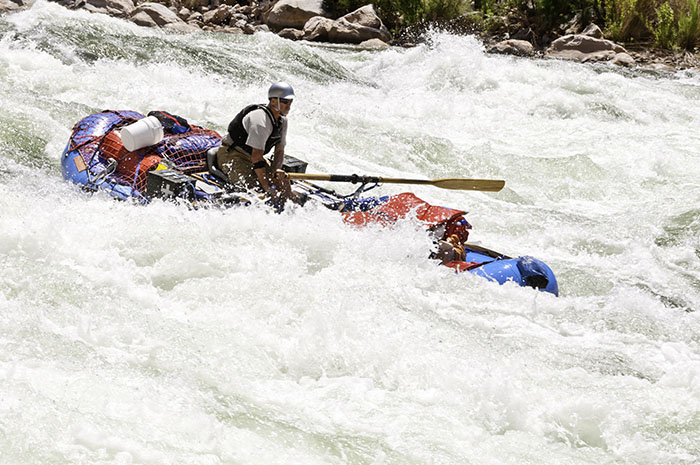 Tackling the mighty Colorado River.
Tackling the mighty Colorado River. On my first day out on an American river, I found myself gorge-gazing from the depths of the Glenwood Canyon while paddling the iconic Colorado River’s undulating class IV and V rapids. My initiation to proper granite rock climbing was outside the famous recreational haven of Lake Tahoe, at Donner Summit – where some of the greatest American adventure athletes (namely Adrian Ballinger) play and train. The only time I’ve ever failed to make a mountain’s summit was while climbing in whiteout blizzard conditions on Mount Hood in Oregon’s Mount Hood National Forest, when my hair froze into icicle braids and our climbing team had to ski down the mountain with zero visibility and total control. My first 80km race ran through the Golden Gate National Recreation Area – where warm Pacific breezes, giant redwoods and quiet coves give way to rolling hills that feel impossibly far away from civilisation in the San Francisco Bay area.
Each of America’s natural landscapes, which together construct the expanses of our wild lands, have taught me that adventure in the American outdoors burns like the eternal flame. Exploration in these national parks and recreation areas is a timeless challenge that revives the thrill of discovery washed away by the ease of metropolitan travel in the United States. All it takes is a step off the beaten track to discover something new and go wild in the wild.
Story by Lauren Steele.
Take a look at our American holiday deals today.


